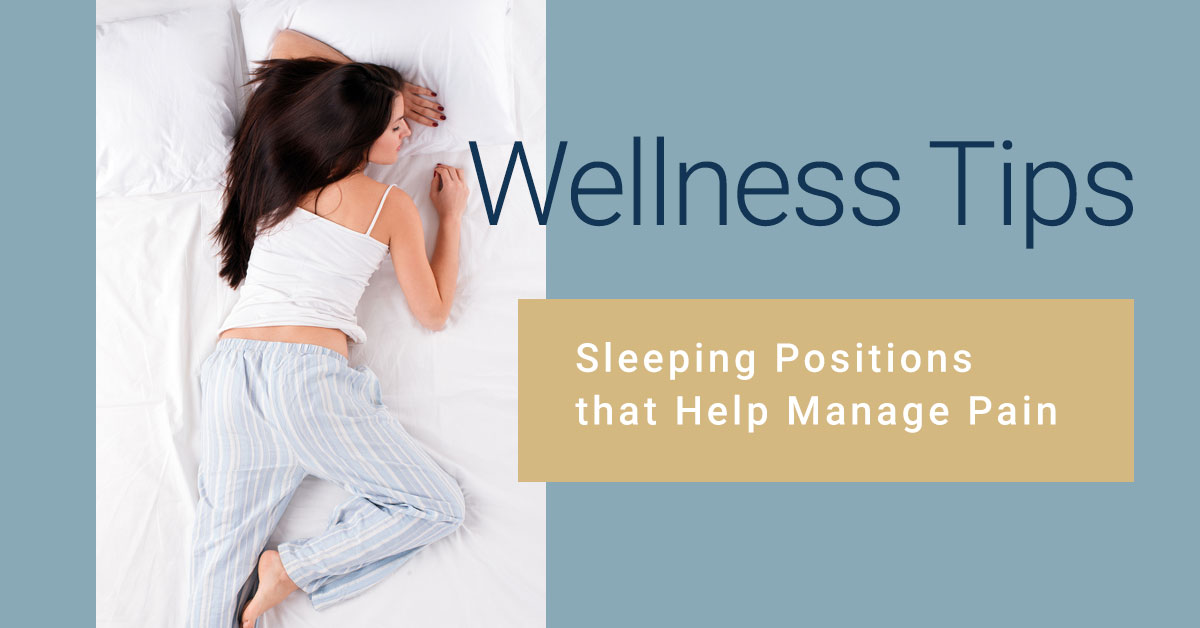
Wellness Tips: Sleeping Positions that Help Manage Pain
You spend almost a third of your life in bed. Getting a good night’s rest isn’t just about what time you go to bed and wake up, it also depends on your sleep position. The position you sleep in has a direct correlation to the way your body feels during your waking hours. If you experience chronic pain in your back, shoulder, arm, or neck, you might want to consider changing your sleeping position.
Back Pain
If you experience back pain, there can be many reasons for it to occur which may affect how you sleep. We aren’t going to go into detail for each type of back pain, but we will go through some tips you can try to see what works for you.
If you prefer to sleep on your back but experience pain or soreness in your lower back, try placing a pillow under the back of your thighs to take some of the pressure off.
Using a pillow between your knees if you’re a side sleeper can reduce rotation of the lumbar spine by keeping the knees together. This can be helpful for those who have a wider pelvis as it can reduce the load placed on the low back.
Play around with having your legs straight, knees slightly bent and closer towards your chest (around or less than 90 degrees) to find the most comfortable position. You should try to keep a slight inward dip in your low back.
When you’re lying on your side your back should be straight, so to reduce twisting the low back if you prefer one leg straight and your top leg bent, try resting the bent knee it on a pillow instead.
Shoulder and Arm Pain
Pain in the arm or shoulder area can make sleeping hard because it can be difficult to find a comfortable position. The best sleeping positions for this is usually on your back or side. Try holding your hands together over your stomach or keeping your arms straight by your side if you’re on your back so your arms can rest on the mattress.
If that’s uncomfortable try sleeping on your side and be mindful of letting your shoulder ride up to your ear on the side closest to the mattress. Laying on your good side and resting your arm on a pillow to reduce putting any undue strain through the shoulder can be helpful too.
Sleeping on your stomach can be quite problematic for shoulder problems as it will often cause you to have one arm in an overhead position which can impinge on certain structures around the shoulder joint if they are inflamed.
Neck Pain
One of the most common questions we hear from people we see with neck pain is “What pillow should I use?”. Whilst we are currently unaware of a particular type of pillow that stands above the rest, the most important thing we feel to consider is how you position it to support your neck.
If your head is in an unnatural position during the night, it can reinforce poor postural habits that you may adopt throughout the day. Not all neck pain derives from a pillow, but sleeping awkwardly can make it worse.
The ideal sleeping position is on your back or side with a pillow that keeps your head at a level that is neutral to your spine, keeping your earlobes in line with the tops of your shoulders.
If you are sleeping on your back and the pillow is too thick, it will push your head up towards the ceiling, reinforcing a forward head posture. You may want to consider just using one pillow with a suitable thickness for this position, ensuring that it has a snug fit into the arch of your neck.
Sleeping on your side is more difficult to gauge if you’re in the right position. Essentially the main position we want to strive for is to make sure that the pillow is nestled nicely into the neck for support and that it isn’t too thin that it allows your head to drop down towards the mattress and that it isn’t too thick that it’s tilting your head up to the side. Whether you use a hand or arm under the pillow too, you should accommodate for this and get someone to check that your head is continuing with the straight line throughout the spine that we touched base on earlier.
Sleeping on your stomach can be hard on your neck because it can cause it to be rotated to one side all night. The twisting motion can cause stiffness or soreness in the neck which is best avoided.
Pillow Fillings
There is a large variety of different pillow fillings which some people swear by but this may not work for everyone. This is all down to personal preference and finding what works well for you. Some people prefer the contoured pillows of a memory foam pillow which can be quite firm, whereas some people would prefer the more common cotton, polyester, latex or down filled pillows which you may need to plump from time to time. For our more conscientious readers who would prefer a non-synthetic, more sustainable pillow filling, we often suggest trying a kapok filled pillow.
The Ultimate Consideration
When considering your sleeping position, always try to line your spine up in a straight, neutral position. Whether you change your pillow or your position, it is important to sleep comfortably with good circulation and good support. If you do notice that you are consistently waking in pain with one of the areas we have discussed, please remember these are pain management techniques. They are no substitute for taking action to see your chiropractor or other qualified health professional to see if there is something that can be resolved with appropriate advice or treatment.


